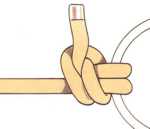
Nautical Knots and Their Uses in Boating
It’s important to learn the basics of boating before setting out on the water. Knowing about the different types of nautical knots and how to use them will be helpful both during regular boating excursions and in the event of an emergency.
While the law doesn’t require the use of sailing knots on a boat, we strongly recommend learning about them, because they will undoubtedly come in handy!
In this article, we present 5 indispensable nautical knots for boaters and what they’re used for.
The importance of nautical knots
Knowing how to tie nautical knots is a vital skill for anyone who wants to sail the seas or join a crew for a long voyage.
Most sailing knots aren’t too difficult to learn, but it’s important to practice them many times over to make sure that you can tie them reliably and securely. Here are the different categories of nautical knots and what they’re used for:
- Loop: This type of knot is used to create a strong loop that allows the rope to be attached to a fixed point (sail fasteners or mooring cleat).
- Hitch: This type of knot is used to tie a taut rope to something. One example of this type of knot is the clove hitch.
- Stopper knot: As its name suggests, a stopper knot is used primarily at the end of a rope to create a stopping point for pulleys and other rope guides.
- Bend: This type of knot attaches two ropes together.
- Decorative knot: This type of knot has little practical use and is mostly meant for decoration.
The 5 main types of nautical knots
As we explain in our online course, there are many different types of nautical knots. Here are the 5 that we believe are most useful for boaters.
1. Bowline
A bowline knot creates a strong, fixed loop that won’t slide or come apart while under tension. It is widely considered to be one of the most useful nautical knots, particularly when it comes to mooring a boat.
Find out how to tie a bowline knot here!
2. Figure-eight knot
The figure-eight knot is a boating knot that’s quite useful and popular among sailors. It’s also used in other activities such as rock climbing.
The figure-eight knot is a stopper knot and decorative element that can be placed at each end of a rope. This handy technique will keep your knot from slipping, making it easier to untie as well!
3. Reef knot (square knot)
The reef knot, also called a square knot, is commonly used and easy to master. This bend knot consists of two inverted half knots and is an easy way to tie two ends of a rope together.
Note that a reef knot should not be used to attach two ropes of different diameters. Otherwise, it may come undone. It’s best to think of it as more of a temporary attachment.
4. Clove hitch
The clove hitch is a classic hitch knot, meaning that it’s used to attach a taut rope to a fixed point. It can be tied to a bitt for mooring purposes or used to fasten a fender.
Note that while this type of nautical knot is very solid, it can come undone if the rope slackens. It should therefore be used with caution.
5. Anchor bend
The anchor bend is one of the most useful knots for securing a boat. It has many advantages—it’s easy and safe to use and won’t slip in an emergency situation where quick action is needed.
However, it is a very difficult knot to undo, which makes it perfect for tying an anchor to an anchor rode.
Learn more about nautical knots with the National Boating Safety School
We hope this article helped you gain a better understanding of nautical knots and their uses. If you’d like to find out more about sailing knots and how they can help you boat safely, the National Boating Safety School is a great resource.
Our online boater safety course is easy to follow and includes everything you need to know about boating safety. Feel free to contact us for more information. We’ll be happy to answer your questions.




